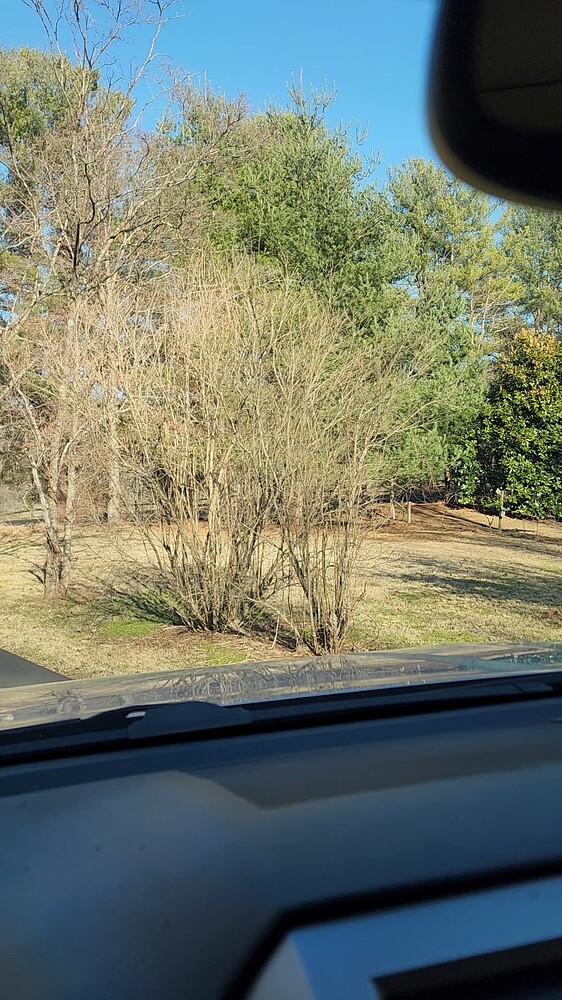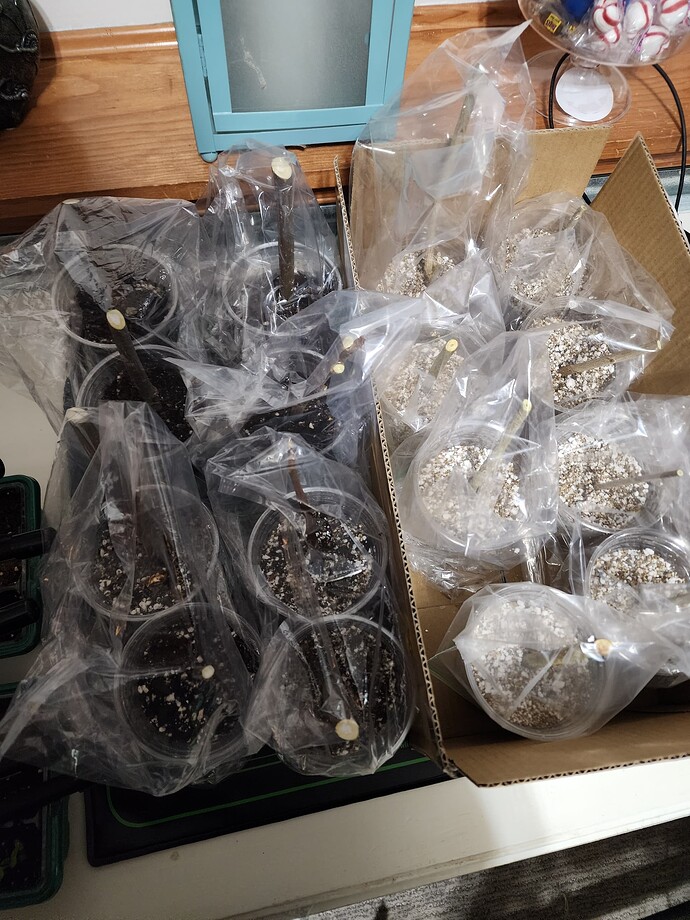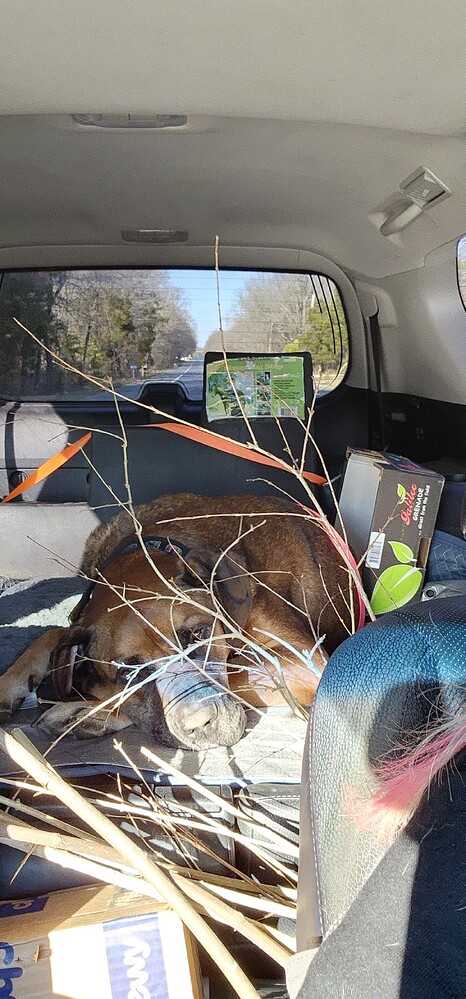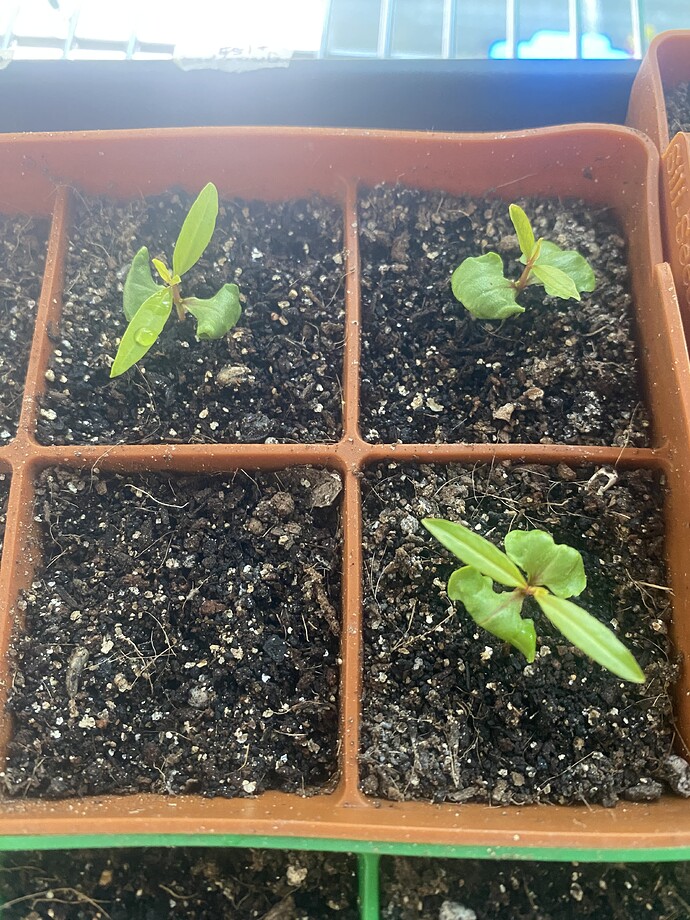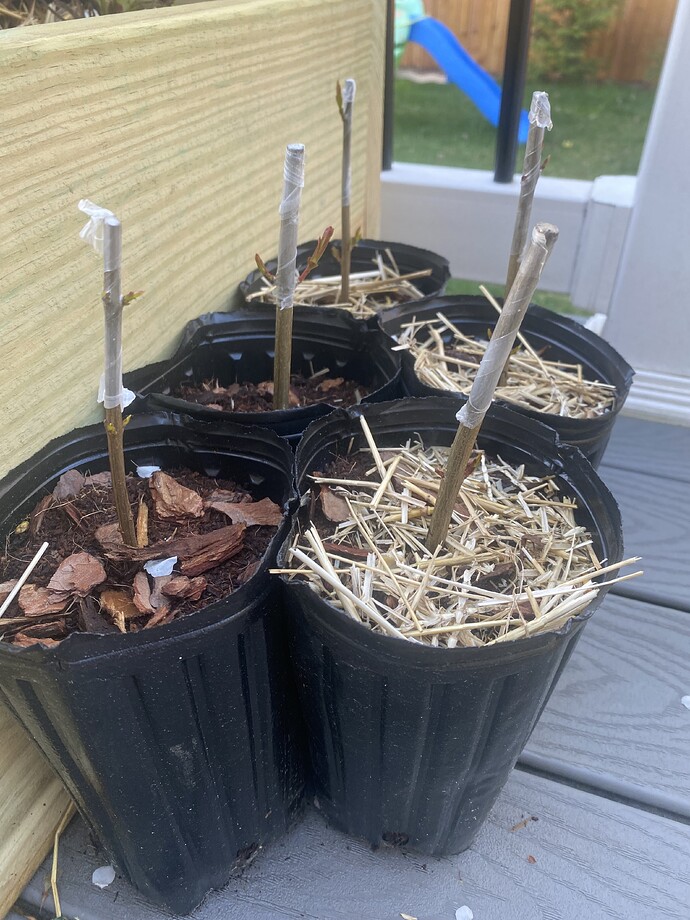Thank you so much for the details! Do you attach the trellis to the outside of the pot somehow? Or do you put it inside the pot at the time of transplant? I love this idea and will certainly try when mine are up to size.
Hi Eme,
I have done both. If you go inside the pot use a rot resistant wood.
I am also experimenting with grafting onto dwarf rootstock. The goal would be to have desirable fruits like Azadi and Parfianka growing on small (4-6 ft) plants that can be protected using plastic and water jugs outside under low tunnels and not moved. I am using Agat as my main dwarf rootstock. If you are on the East Coast keeping the plants dry is very helpful to cut back on fungal disease. Many growers have become dissillusioned by the frustration of fruit drop and rotting fruit. Tiny, cheap low tunnel type greenhouses could be a part of the solution.
Very interesting. I gathered that as well from reading all these threads and have been scheming plans to cover my plants or bring them inside with too much rain/wet. I think you should teach a course on successfully growing pomegranates on the east coast! I am hoping that the heat of my deck helps to combat the natural humidity and rain in my area as well, while also knowing I need to protect the roots/pots from the heat. I also found a study talking about “Fleishman” being resistant to acthranose like Azadi. I found someone selling cuttings and ordered to try. And switched out my incoming strawberry varieties with ones at least known for some resistance to it. We’ll see what this year brings.
Hi Eme,
The flat nature of Espalier definitely helps the plants to dry out quickly. I have used sulphur spray mixed with neem to control fungus on the outdoor espalier poms. The combination of espalier, sulfur and neem helps with fungal infections, but I have only produced good fruit on Salavatski outdoor using this method. I am going to espalier Azadi and keep it outdoors this season and publish my results in the fall. The university of Florida has some good studies on fungal resistance. It sounds like you may have already accessed their results. One of the problems I am still battling is premature fruit drop. If I ever “crack the code” consistently I will be sharing my results with the public.
I grow strawberries under pomegranates in the greenhouse and I do not see extra fungal issues. Watering is done with drip irrigation and the foliage is kept dry.
Great!
I’ll plant out cold hardy pom seeds! I’m in an especially humid hollow at the base of a ridge - a great crucible in which to test new varieties for fungal resistance.
Do you know if Azadi and Kazake are the same plant? The pictures of kazake are identical to that yellow and then dark arils…Willis has kazake, might add to my order.
‘Azadi’ has very soft seeds, and ‘Kazake’ has hard seeds. ‘Azadi’ is very sweet with little to no noticeable acidity, and ‘Kazake’ has a very good sweet-sour-acid balance. ‘Kazake’ is the more cold hardy of the two. So no, they are very different varieties.
Hi Eme,
Azadi and Kazake are not the same. Kazaki is 2/3 size, tart sweet balance, semi hard seed with highest cold resistance but modest productivity. Azadi is full sized mostly sweet, very little tart fruit, soft seeded and very productive, not particularly cold resistant.
Bryan
Does anyone here know if it’s worth to grow Ariana pomegranate if you already have Parfianka? I hear they’re both good, but quite similar.
Their fruit are nearly identical, yet based upon my research Ariana appears to be the overall better variety for fruit quality.
Hey fellow pomegranate crazy Marylander ![]() . I’m in Charles County. Where are you?
. I’m in Charles County. Where are you?
I learned about a successful pom grower about 30 miles from me via a Facebook post from a local farm with photos of pomegranates given to them by a neighbor. I reached out asking if they could put me in touch with the grower so I could learn more about their setup and see if they’d be willing to let me take some cuttings.
They agreed and Saturday I took my pruners and a couple of small Makedonia pomegranate plants from my collection to gift them with.
It turns out they don’t know what variety they have, they just planted it basically on top of a second one at the same time and have left them alone for 7-10 years, beyond some watering the first year. They said they had so much fruit this year they didn’t know what to do with it all.
I wish I’d taken photos while I was out looking at them, but I snagged some video on the way out and took a screen grab from that.
The dominant bush is at least 10 feet tall. I got enough from a few snips to make 8 cuttings to root, plus a handful stored in the fridge to try grafting to my crepe myrtles when they wake up. They also let me take some cuttings from a MASSIVE fig tree. I was up past midnight Saturday getting them all broken down and into medium.
Poms are on the right, figs on the left.
Bonus pic of my dog sleeping behind the cutting forest on the way home.
Hi! I’m in Montgomery county. It’s only my second year with pomegranates. This thread has been immensely helpful in thinking about what to do to maybe get one edible piece of fruit! I started with a bunch of salavatski plugs last year having read virtually nothing. I gave away half of them, planted 2 and ended up with one potted after my arch nemesis (squirrel) destroyed two. I just dug up my two in ground to change locations and was super impressed by their root systems - and that they survived our rather cold winter despite being extremely small. I plan to espalier them.
I just planted fleishman cuttings from some CA grower on Etsy, potted a bareroot nikitski ranni from Willis and am expecting a red silk to arrive here this week that will also be potted. I’m planning on trying to espalier next year per the successes in this thread and maybe even moving the smaller nikitski ranni and red silk espaliered inside under lights after they are pollinated to see how that compares with outdoor heat/sun/fungus risk. My containers will mostly be on my crazy hot deck, and I’m thinking if I can keep the roots cool enough and trees from burning, the heat might help combat the fungus. Just thoughts; I don’t know what will happen in real life. I plan on getting Azadi and kazake when I recover from the expenses of this spring!
Love the dedication and scrappiness displayed here!
@Eme ! We crazy pomegranate people need to be pretty scrappy. Pomegranates apparently like to give us all a REALLY HARD TIME! LOL
For people who have grown from seed- suggestions? I sprouted these 3 pomegranates over the last month. They’re in a seed starting tray. I know from some plugs I had last year that they have a decent taproot, and I don’t want to trap them. The second set of true leaves is just sprouting. Transplant after that? And, to a tall tree pot? Or quart-ish? No idea the variety; they were from a totally delicious, sweet, soft seeded organic grocery store pomegranate last fall.
Also, my fleishman cuttings from Etsy are doing well pushing leaves. I’ve never grown from cutting- leave them in these pots until next year and then check the roots?
Did you start your cuttings outside? Have they held up through the freeze earlier this week?
I’m curious too about when is best to up pot seedlings. I have a few I started in plastic cups.
